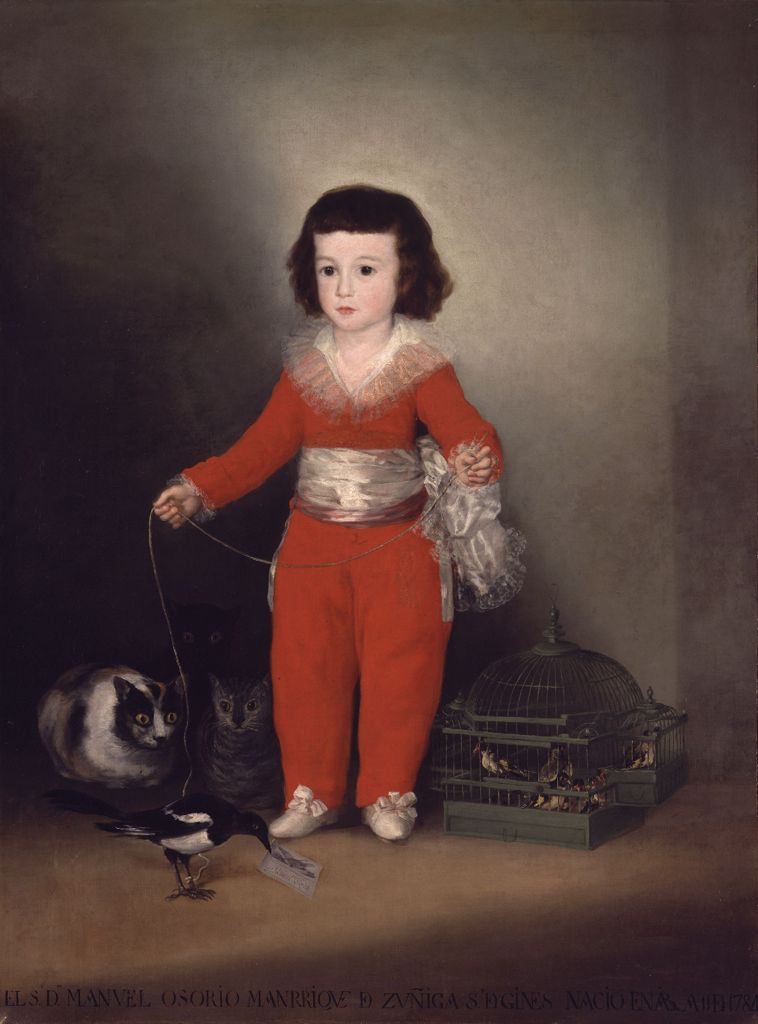Go to the Metropolitan and meet the Altamiras, one of the richest and most illustrious families of 18th Century Spain. Four of Goya’s portraits of the family are assembled in one place for the first time in a century and a half. So illustrious was the family that the father, Vicente Joaquín Osorio Moscoso y Guzmán, 12th Conde de Altamira, was said to have more titles to his name than any Spaniard of his time. And though the family would ultimately lose most of its wealth in the catastrophic upheaval that followed Napoleon’s invasion of Spain in 1808, at the time when Goya painted these four sitters, between 1786 and 1788, they seemed positively pink with prosperity.

Frequent visitors to the Met will already be familiar with two of these works, the Lehman Collection’s pearline portrait of Maria Ignacia Álvarez de Toledo, Condesa de Altamira, holding an infant girl in her arms, and the portrait of Manuel Osorio Manrique de Zuñiga, Maria’s younger son. The latter, a boy in a brilliant red suit who holds a pet bird on a string, has become, in recent years, quite literally the face of the Met, having graced the cover of the guide to the collection, as well as other promotional materials.
 Another fine portrait depicts Vicente Osorio de Moscoso, Conde de Trastámara. The elder son of Vicente and Maria, he was destined, unlike his younger brother, to survive into adulthood. Being the oldest child, who was expected to inherit the title, Vicente Jr. is not depicted, as was his brother, amid the frivolities of childhood, but rather in the staid raiments of precocious adulthood. All of ten years old, he hides his right hand soberly in a fold of his vest in a way that weirdly presages Napoleon, who at the time was a teen-ager himself. Only the little dog barking at his leg gives the lie to his sober-sided expression.
Another fine portrait depicts Vicente Osorio de Moscoso, Conde de Trastámara. The elder son of Vicente and Maria, he was destined, unlike his younger brother, to survive into adulthood. Being the oldest child, who was expected to inherit the title, Vicente Jr. is not depicted, as was his brother, amid the frivolities of childhood, but rather in the staid raiments of precocious adulthood. All of ten years old, he hides his right hand soberly in a fold of his vest in a way that weirdly presages Napoleon, who at the time was a teen-ager himself. Only the little dog barking at his leg gives the lie to his sober-sided expression.
Portrait of Vicente Osorio de Moscoso, Conde de Trastamara by Goya, c. 1787. Oil on canvas, 54 1/2 by 41 inches. Private Collection.
The best of the portraits, perhaps, is that of his father, an extremely tiny man, according to contemporary report. In odd contrast to his precocious son, he looks like an overaged child, whose feet reach the floor with difficulty from the yellow satin chair on which he sits beside a stately writing table of the same hue.
A third son, Juan Maria Osorio, is depicted in a final portrait, not by Goya, but by Agustín Esteve y Marques, an artist far inferior to Goya. And yet, as fine as Goya’s four paintings are, we must not misunderstand the nature of their excellence. We find here little if any psychological penetration. In its place is and an exuberant willingness to flatter the sitters. Goya, the dark and mocking protomodernist, would emerge some years later: for now, these complaisant works exhale the last, lingering enchantments of the ancien regime.

